The global bakery product market is projected to grow from USD 253.4 billion in 2025 to USD 367.9 billion by 2035, registering a CAGR of 3.8%.
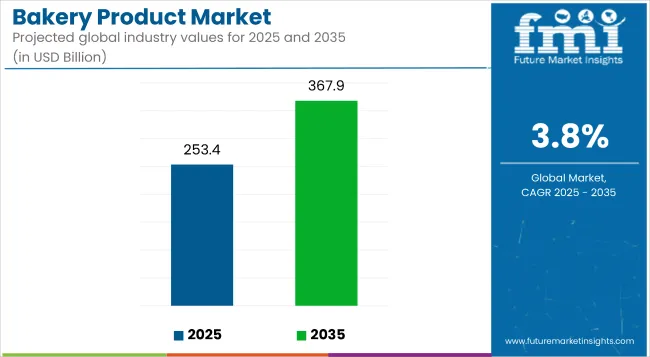
| Metric | Value |
|---|---|
| Industry Size (2025E) | USD 253.4 billion |
| Industry Value (2035F) | USD 367.9 billion |
| CAGR (2025 to 2035) | 3.8% |
The market is projected to expand due to shifting consumer preferences toward healthier and convenient bakery options. Changing lifestyles, including the growing trend of urbanization and increased demand for ready-to-eat foods, are encouraging bakeries to diversify their product offerings. Technological advancements in production, such as automated baking processes and improved storage techniques, are further enhancing the efficiency and availability of bakery products.
The market holds significant shares in several parent markets. It contributes around 16% to the overall food and beverage market, reflecting its central role in daily diets. Within the processed food market, the bakery segment accounts for approximately 14%.
In the packaged food market, it holds a notable share of around 18%, driven by the demand for convenience foods like bread, biscuits, and pastries. In the snacks market, bakery products like cookies and crackers capture approximately 12%. Additionally, the gluten-free food market is increasingly driven by bakery offerings, accounting for about 25.7% of the specialty segment.
Government regulations influencing the market focus on food safety, ingredient labeling, and nutritional content. In regions like the European Union and North America, strict standards on ingredient transparency and product labeling are fostering innovation in healthier bakery alternatives.
Regulations on food safety, such as those outlined by the FDA and EFSA, ensure that producers adhere to the highest quality standards, driving demand for products that meet consumer health and safety expectations.
Japan is projected to be the fastest-growing market, expected to expand at a CAGR of 5.1% from 2025 to 2035. Indirect leads the distribution channel segment with a 65% share, while biscuits will dominate the product type segment with a 34.2% share. The UK and USA markets are expected to grow steadily at CAGRs of 3.9% and 4.2%, respectively.
The market is segmented by product type, specialty type, distribution channel, and region. By product type, the market is divided into biscuits (cookies, non-salt cracker biscuits, salt cracker biscuits, milk biscuits, cream biscuits, glucose biscuits and marie biscuits and others), bread & rolls (artisanal, in-store, and packaged types), cakes & pastries (artisanal, in-store, packaged, pizza crusts, and rusks).
By specialty type, the market is classified into gluten-free, fortified, organic, low-calorie, and sugar-free products. In terms of distribution channels, the market is bifurcated into direct and indirect (hypermarkets/supermarkets, convenience stores, bakery stores, artisanal bakeries, and online retailers). Regionally, the market is segmented into North America, Latin America, Western Europe, Eastern Europe, South Asia & Pacific, East Asia, and the Middle East & Africa.
The biscuits segment is expected to dominate the global market, accounting for 34.2% of the market share by 2025. This growth is driven by increasing demand for various biscuit types and their convenience.
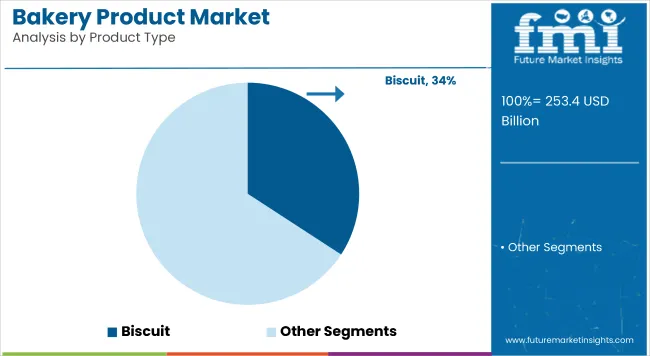
Gluten-free products are anticipated to lead the specialty type segment, securing 25.7% of the market share by 2025. This growth is driven by rising health awareness and increasing demand for gluten-free bakery options.
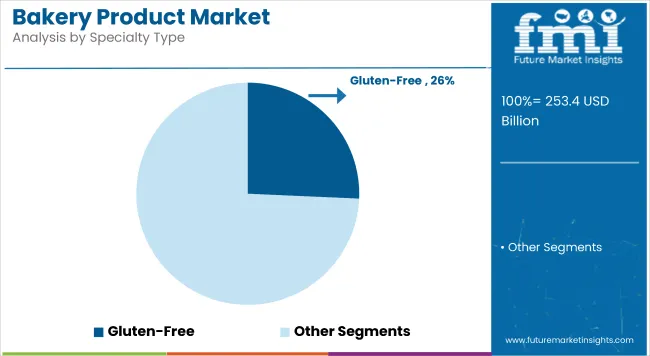
Indirect is projected to dominate the distribution channel segment, accounting for 65% of the market share by 2025, driven by the widespread availability of bakery products through hypermarkets, supermarkets, convenience stores, and e-commerce platforms.
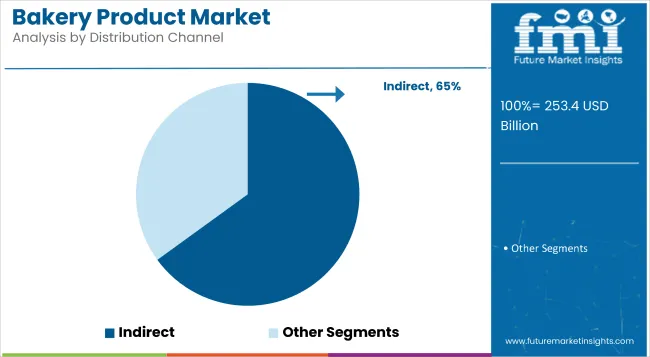
The global bakery product market is experiencing steady growth, driven by shifting consumer preferences towards healthier and convenient food options. Bakery products play a crucial role in meeting the increasing demand for quick, nutritious, and indulgent food choices across all demographics.
Recent Trends in the Bakery Product Market
Challenges in the Bakery Product Market
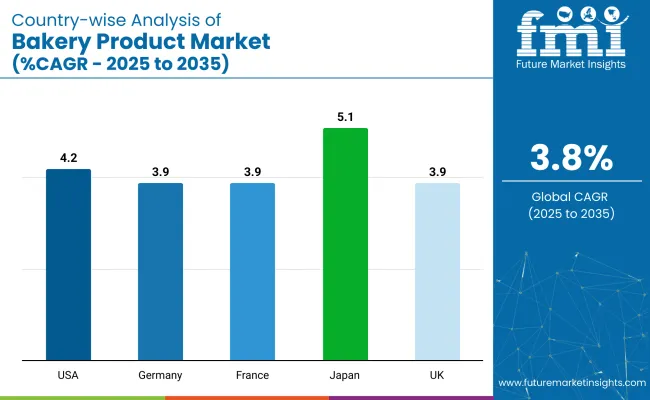
Japan's momentum is driven by high-tech food production, innovation in gluten-free and low-calorie bakery options, and regulatory alignment with health-conscious consumer trends. Germany and France maintain consistent demand, supported by EU directives on food safety, sustainable production, and regional agricultural support. Developed economies like the USA (4.2% CAGR), UK (3.9%), and Japan (5.1%) are growing at steady rates of 1.1-1.3x the global growth rate.
Japan leads the bakery product market, driven by strong demand for premium, gluten-free, and low-calorie products. The USA follows closely, with rising consumer preferences for organic, gluten-free, and low-carb bakery products, alongside a focus on innovation.
Germany and France show steady growth, supported by EU sustainability and food safety regulations, along with increasing demand for organic and healthier products. The UK also grows steadily, with an emphasis on low-sugar, low-fat, and gluten-free options, despite slower capital investment following Brexit.
The report covers in-depth analysis of 40+ countries; five top-performing OECD countries are highlighted below.
The Japan bakery product revenue is growing at a CAGR of 5.1% from 2025 to 2035. Growth is driven by high demand for premium, gluten-free, and low-calorie bakery products. Japan's market prioritizes food safety standards and innovation in healthier alternatives, particularly in urban regions.
The sales of bakery products in Germany are expected to expandat a 3.9% CAGR during the forecast period, slightly above the global average, driven by EU sustainability and food safety standards. Key applications include organic and fortified bakery products in retail and foodservice sectors.
The French bakery product market is projected to grow at a 3.9% CAGR during the forecast period, driven by national health regulations and increasing demand for gluten-free and organic products. The market is heavily influenced by EU funding for sustainable food production and increasing awareness of healthy eating.
The USA bakery product market is projected to grow at a 4.2% CAGR from 2025 to 2035, translating to 1.1x the global rate. USA demand is heavily tied to the growing preference for healthier, organic, and gluten-free bakery products, with a significant shift toward low-carb and sugar-free options.
The UK bakery product revenue is projected to grow at a 3.9% CAGR from 2025 to 2035, representing steady growth slightly below the global pace. Growth is driven by increasing consumer demand for health-conscious products such as low-sugar, low-fat, and gluten-free bakery options.
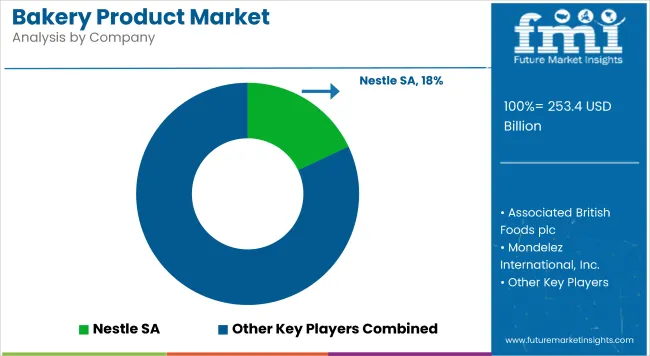
The market is moderately consolidated, with leading players such as Nestle SA, Associated British Foods plc, Mondelez International, Inc., Finsbury Food Group Plc, and Bimbo Bakeries USA dominating the industry. These companies provide a wide range of innovative bakery products catering to sectors like retail, foodservice, and packaged foods. Nestle SA focuses on offering healthier, ready-to-eat bakery options, while Mondelez International, Inc. specializes in producing popular snack biscuits and cookies.
Bimbo Bakeries USA is known for its diverse bread and baked goods portfolio, while Britannia Industries provides both traditional and health-conscious bakery items. Flowers Foods, Inc. offers a variety of packaged bread and snack cakes, and Rich Products Corporation is known for its frozen bakery solutions. Other key players like Dr. August OetkerNahrungsmittel KG, Gruma, S.A.B. de C.V., Bakers Delight Holdings, Grupo Bimbo S.A.B de C.V., Yamazaki Baking Co., Ltd., and JAB Holding Company contribute by providing specialized products, including gluten-free, organic, and low-calorie bakery goods for a wide range of consumer needs.
Recent Bakery Product Industry News
| Report Attributes | Details |
|---|---|
| Market Size (2025) | USD 253.4 billion |
| Projected Market Size (2035) | USD 367.9 billion |
| CAGR (2025 to 2035) | 3.8% |
| Base Year for Estimation | 2024 |
| Historical Period | 2020 to 2024 |
| Projections Period | 2025 to 2035 |
| Report Parameter | USD billion for value/Volume in Units |
| Product Type Analyzed | Biscuits (Cookies, Non-Salt Cracker Biscuits, Salt Cracker Biscuits, Milk Biscuits, Cream Biscuits, Glucose Biscuits, Marie Biscuits, Others), Bread & Rolls (Artisanal, In-Store, Packaged), and Cakes & Pastries (Artisanal, In-Store, Packaged, Pizza Crusts, Rusks) |
| Specialty Type Analyzed | Gluten-Free, Fortified, Organic, Low-Calorie, and Sugar-Free |
| Distribution Channel Analyzed | Direct and Indirect (Hypermarkets/Supermarkets, Convenience Stores, Bakery Stores, Artisanal Bakeries, Online Retailers) |
| Regions Covered | North America, Latin America, Western Europe, South Asia, East Asia, Eastern Europe, Middle East & Africa |
| Countries Covered | United States, United Kingdom, Germany, France, Japan, China, India, Brazil, South Korea, Australia |
| Key Players Influencing the Market | Nestle SA, Associated British Foods plc, Mondelez International, Inc., Finsbury Food Group Plc, Bimbo Bakeries USA, Britannia Industries, Flowers Foods, Inc., Rich Products Corporation, Dr. August Oetker Nahrungsmittel KG, Gruma, S.A.B. de C.V., Bakers Delight Holdings, Grupo Bimbo S.A.B. de C.V., Yamazaki Baking Co., Ltd., JAB Holding Company |
| Additional Attributes | Dollar sales by product type, share by specialty type, regional demand growth, policy influence, health trends, competitive benchmarking |
The market is valued at USD 253.4 billion in 2025.
The market is forecasted to reach USD 367.9 billion by 2035, reflecting a CAGR of 3.8%.
Biscuits will lead the product type segment, accounting for 34.2% of the global market share in 2025.
Indirect will dominate the distribution channel segment with a 65% share in 2025.
Japan is projected to grow at the fastest rate, with a CAGR of 5.1% from 2025 to 2035.






Our Research Products

The "Full Research Suite" delivers actionable market intel, deep dives on markets or technologies, so clients act faster, cut risk, and unlock growth.

The Leaderboard benchmarks and ranks top vendors, classifying them as Established Leaders, Leading Challengers, or Disruptors & Challengers.

Locates where complements amplify value and substitutes erode it, forecasting net impact by horizon

We deliver granular, decision-grade intel: market sizing, 5-year forecasts, pricing, adoption, usage, revenue, and operational KPIs—plus competitor tracking, regulation, and value chains—across 60 countries broadly.

Spot the shifts before they hit your P&L. We track inflection points, adoption curves, pricing moves, and ecosystem plays to show where demand is heading, why it is changing, and what to do next across high-growth markets and disruptive tech

Real-time reads of user behavior. We track shifting priorities, perceptions of today’s and next-gen services, and provider experience, then pace how fast tech moves from trial to adoption, blending buyer, consumer, and channel inputs with social signals (#WhySwitch, #UX).

Partner with our analyst team to build a custom report designed around your business priorities. From analysing market trends to assessing competitors or crafting bespoke datasets, we tailor insights to your needs.
Supplier Intelligence
Discovery & Profiling
Capacity & Footprint
Performance & Risk
Compliance & Governance
Commercial Readiness
Who Supplies Whom
Scorecards & Shortlists
Playbooks & Docs
Category Intelligence
Definition & Scope
Demand & Use Cases
Cost Drivers
Market Structure
Supply Chain Map
Trade & Policy
Operating Norms
Deliverables
Buyer Intelligence
Account Basics
Spend & Scope
Procurement Model
Vendor Requirements
Terms & Policies
Entry Strategy
Pain Points & Triggers
Outputs
Pricing Analysis
Benchmarks
Trends
Should-Cost
Indexation
Landed Cost
Commercial Terms
Deliverables
Brand Analysis
Positioning & Value Prop
Share & Presence
Customer Evidence
Go-to-Market
Digital & Reputation
Compliance & Trust
KPIs & Gaps
Outputs
Full Research Suite comprises of:
Market outlook & trends analysis
Interviews & case studies
Strategic recommendations
Vendor profiles & capabilities analysis
5-year forecasts
8 regions and 60+ country-level data splits
Market segment data splits
12 months of continuous data updates
DELIVERED AS:
PDF EXCEL ONLINE
Personalized Bakery Products Market Analysis by Product Type, Price Range, Sales Channel, End-User and Region 2025 to 2035
Ready-to-Finish Bakery Products Market Analysis - Size, Share and Forecast 2025 to 2035
Product Tour Software for SaaS Market Size and Share Forecast Outlook 2025 to 2035
Bakery Stabilizers Market Size and Share Forecast Outlook 2025 to 2035
Bakery Ingredients Market Analysis - Size, Share, & Forecast Outlook 2025 to 2035
Product Life-Cycle Management (PLM) IT Market Size and Share Forecast Outlook 2025 to 2035
Bakery Packaging Machine Market Size and Share Forecast Outlook 2025 to 2035
Product Analytics Software Market Size and Share Forecast Outlook 2025 to 2035
Products from Food Waste Industry Analysis in Korea Size, Share and Forecast Outlook 2025 to 2035
Products from Food Waste in Japan - Size, Share, and Forecast Outlook 2025 to 2035
Bakery Mixes Market Analysis - Size, Share, & Forecast Outlook 2025 to 2035
Production Logistics Market Size and Share Forecast Outlook 2025 to 2035
Products from Food Waste Market Analysis - Size, Growth, and Forecast 2025 to 2035
Product Design Verification And Validation Solution Market Size and Share Forecast Outlook 2025 to 2035
Bakery Enzymes Market Analysis - Size, Share, and Forecast Outlook 2025 to 2035
Bakery Emulsions Market Analysis - Size, Share, and Forecast Outlook 2025 to 2035
Bakery Cases Market Analysis – Trends, Growth & Forecast 2025 to 2035
Production Printer Market - Growth, Demand & Forecast 2025 to 2035
Bakery Processing Equipment Market Analysis by Product Type, End User, Application & Region: A Forecast for 2025 and 2035
Competitive Breakdown of Bakery Mixes Suppliers

Thank you!
You will receive an email from our Business Development Manager. Please be sure to check your SPAM/JUNK folder too.
Chat With
MaRIA